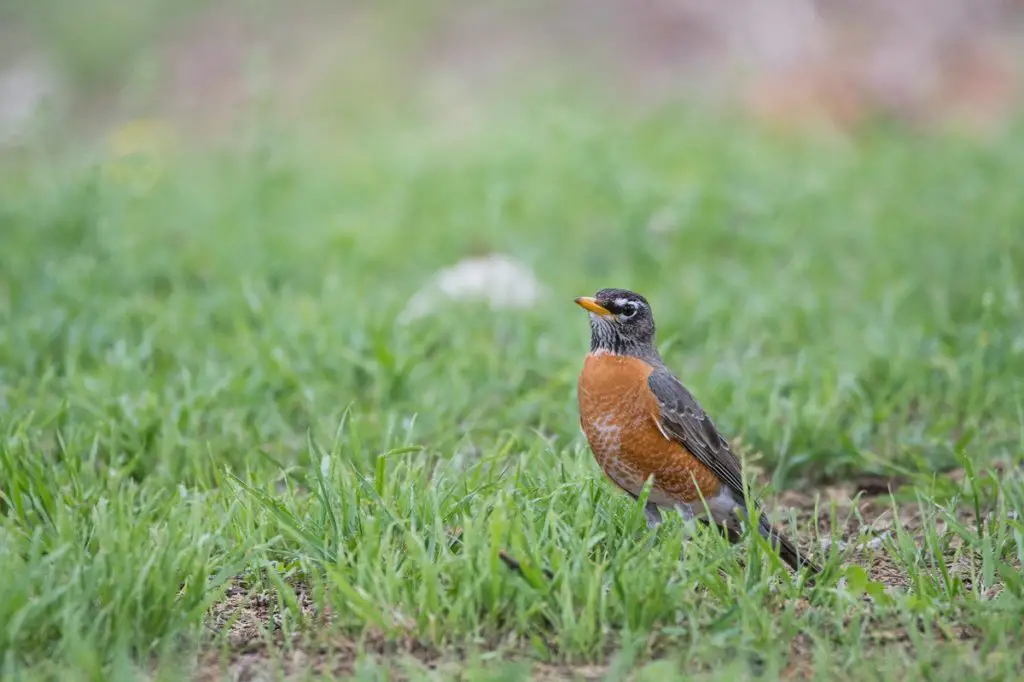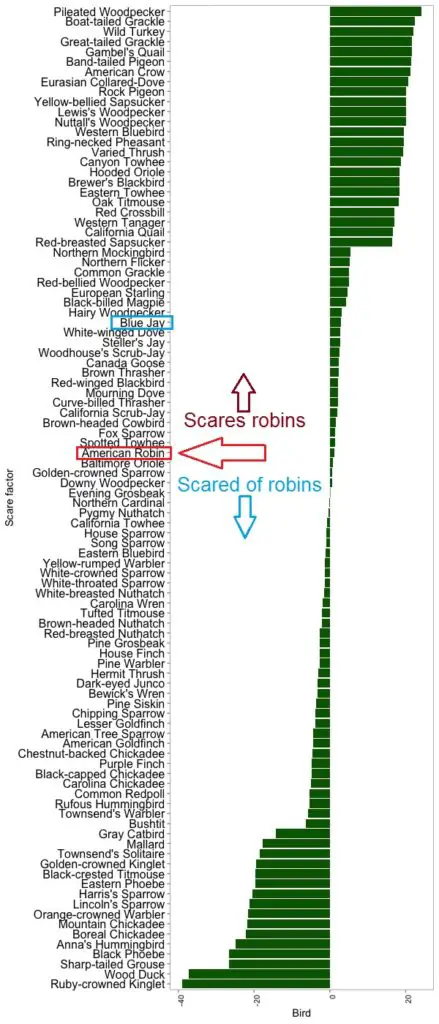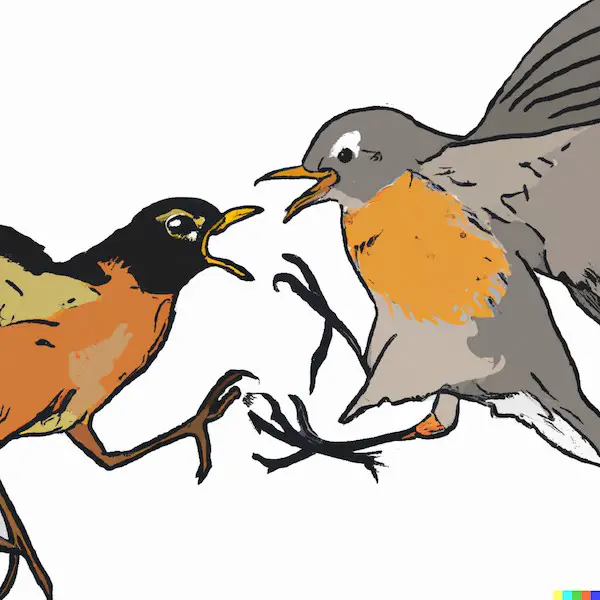Do robins kill their babies? This is a question I often get asked by curious readers and bird enthusiasts alike.
The short answer is, yes – robins may sometimes kill their own offspring, but this behavior is uncommon and occurs under specific circumstances.
In this blog post, I will delve deeper into this intriguing topic and share my first-hand experiences and knowledge on the matter. We’ll explore the reasons behind this behavior and the various factors that can influence it, as well as some interesting facts about robins and their breeding habits.
Parental Care in Robins
Parental care and infanticide are two contrasting behaviors observed in some bird species, including robins. While robins are generally known for their dedicated parental care, just as for many other bird species, there have been occasional reports of infanticide within this species as well.
Parental care in robins typically involves both the male and female birds. They form monogamous pairs during the breeding season and work together to raise their offspring.
The female robin builds a cup-shaped nest, usually in a shrub or tree, using materials such as grass, twigs, and leaves. Once the nest is constructed, the female lays a clutch of eggs, usually ranging from 3 to 5 eggs, and begins incubating them.
During this period, which lasts around 12-14 days, the male robin assists by providing food to the female.
After the eggs hatch, both parents continue to care for the nestlings. They take turns feeding the chicks with a diet consisting of insects, spiders, worms, and other small invertebrates. The parents also remove waste from the nest to maintain cleanliness and reduce the risk of disease. This parental care continues for several weeks until the young robins fledge and become independent.

However, infanticide, which is the killing of young offspring, has been observed in robins under certain circumstances. This behavior is usually displayed by the male robin. It occurs when a new male takes over a territory with an active nest containing young chicks.
The same behaviour is seen in other birds such as sparrows and is somewhat more well-known in storks.
In an effort to maximize his reproductive success, the new male may kill the existing nestlings, thereby eliminating potential competition for resources and increasing the chances of siring his own offspring with the female.
Infanticide in robins is relatively rare but has been documented in scientific studies. It is thought to be an adaptive strategy employed by some males to enhance their own reproductive success. However, it is important to note that not all male robins engage in infanticidal behavior, and many successfully co-parent with the female and raise their young.
Overall, while robins are generally known for their diligent parental care, infanticide can occur in certain circumstances, primarily involving territorial conflicts and the arrival of new males in an established nest.
The Role of Both Parents
When it comes to raising their young, robins exhibit a remarkable level of cooperation between both parents. The male and female will take turns incubating the eggs, and once the babies hatch, both parents work tirelessly to provide them with food and protection.

This strong parental bond and dedication to their offspring make the idea of robins killing their own babies seem even more puzzling.
The Demands of Providing Food
As the babies grow, the demands for food increase, and both parents must spend more time away from the nest in search of insects and other sources of nourishment.
This leaves the babies more vulnerable to predators, such as snakes, squirrels, and other birds. It is during this period of increased vulnerability that instances of infanticide may occur.
Reasons Behind Infanticide in Robins
Competition for Limited Resources
One of the primary reasons robins might kill their own offspring is due to competition for limited resources. If food becomes scarce, the parents may decide to cull one or more of their babies to ensure the survival of the remaining chicks.
This may seem cruel, but it is a harsh reality of nature and a strategy to maximize the chances of passing on their genes to the next generation.
The Presence of Parasites
Another reason for infanticide in robins is the presence of parasites, such as blowfly larvae, which can infest the nest and feed on the blood of the baby birds. If a parent robin detects that one of its offspring is infested with parasites, it may decide to remove the affected baby from the nest to prevent the parasites from spreading to the other chicks.
In some cases, this removal may involve killing the infested baby.
Deformed or Unhealthy Offspring
If a robin notices that one of its babies is deformed or appears unhealthy, it may choose to kill the affected offspring. This is because deformed or unhealthy babies have a lower chance of survival and may require more resources and attention from the parents, which could jeopardize the well-being of the other chicks.
In this case, the act of killing the unhealthy offspring is a means of ensuring the survival and success of the remaining babies.
The Rarity of Infanticide
It is important to note that infanticide in robins is relatively rare, and the vast majority of robin parents will do everything in their power to protect and nurture their offspring.

Instances of infanticide are usually a last resort and only occur under extreme circumstances when the parents perceive a genuine threat to the survival of their remaining offspring.
A Fascinating Aspect of Avian Behavior
The phenomenon of infanticide in robins, while unsettling, is a fascinating aspect of avian behavior that provides insight into the complex decision-making processes that animals engage in to ensure the survival of their species.

The American Robin is somewhere in the middle of the bird-feeder hierarchy of birds despite its relatively small size. This means it is threatening enough to scare a lot of birds such as the Northern Cardinal, Downy Woodpecker, House Sparrow and the Carolina Wren.
But normally, they mostly fight members of their own species…

By understanding the reasons behind this behavior, we can gain a deeper appreciation for the challenges that robins and other birds face in their daily lives.
Conclusion
In conclusion, while it is true that robins may sometimes kill their babies, this behavior is uncommon and occurs under specific circumstances, such as competition for limited resources, the presence of parasites, or the detection of deformed or unhealthy offspring.
The following are ten facts about robins and their breeding habits that shed light on this fascinating species:
1. Robins are known for their strong parental bond and cooperation in providing for their offspring.
2. Both male and female robins take turns incubating their eggs and feeding their babies.
3. Robins typically lay between 3-5 eggs per clutch.
4. The incubation period for robin eggs is approximately 12-14 days.
5. Baby robins leave the nest around 14-16 days after hatching.
6. Robins can have multiple broods in a single breeding season.
7. The primary diet of baby robins consists of insects and other invertebrates.
8. The survival rate of baby robins is relatively low, with only around 25% making it to adulthood.
9. Robins are known to build their nests in a wide variety of locations, including trees, shrubs, and even on human-made structures.
10. Infanticide in robins is a rare occurrence, and the majority of robin parents are dedicated to protecting and nurturing their offspring.
FAQs
Why would a mother Robin abandon her babies?
There are several reasons why a mother Robin may abandon her babies, including disturbance or predation of the nest, illness or injury of the mother, or inadequate food supply.
Why would a robin abandon her hatchlings?
There could be various reasons why a robin might abandon her hatchlings, such as disturbance or predation of the nest, disease or illness, or lack of food resources.
How do you take care of abandoned baby robins?
It is best to contact a licensed wildlife rehabilitator to care for abandoned baby robins, as they require specialized care and diet. Handling them without proper knowledge and experience can be harmful to their health and survival.
How long can robin eggs survive without mother?
Robin eggs can survive for up to 24 hours without the mother, but it is important to keep them warm and protected during this time.
Can a baby robin survive on the ground?
Yes, a baby robin can survive on the ground for a short period of time while it learns to fly, but it is vulnerable to predators and should be monitored closely by its parents or a wildlife rehabilitator.
Do robins leave their babies unattended?
Yes, robins do leave their babies unattended for periods of time while they search for food. However, they continue to monitor their young and return frequently to check on them and provide food.





